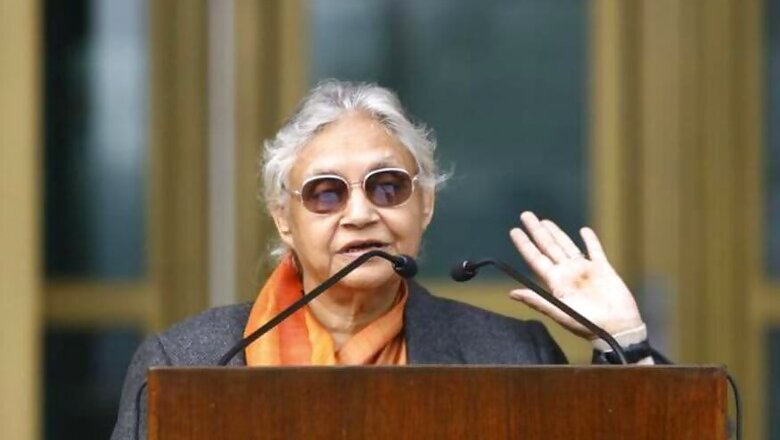
views
Delhi Assembly is celebrating 25 years of its existence in its present form. In keeping with the current political trend in the national capital, this event too has courted controversy.
The polls in Delhi Assembly, ever since it came into existence in 1993, used to be held along with Madhya Pradesh, Chhattisgarh (since 2003), Rajasthan and Mizoram. The cycle broke in 2013 following the emergence of the Aam Aadmi Party (AAP).
The polls five years ago threw up a hung House in the national capital and Arvind Kejriwal became Chief Minister for the first time, with the support of eight Congress MLAs. Kejriwal did not hold onto the chair for long and soon resigned from office, leading to subsequent dissolution of the Assembly and fresh polls in 2015.
Kejriwal’s rise in Delhi was at the cost of the Congress party, which, till then, had won three Assembly elections (1998, 2003 and 2008) under the stewardship of Sheila Dikshit, who held the office of the Chief Minister for three terms. Despite pursuing development-oriented politics, Dikshit could not withstand the political tsunami created by charges of corruption brought mostly against central Congress leaders, and faced humiliating defeat in 2013.
Five years later, Sheila Dikshit is itching for battle once again. In the past five years, her services were used by the party first in Kerala as Governor and later in Uttar Pradesh as the chief ministerial face of an aborted poll campaign. Having recuperated from a heart ailment, Dikshit has said even on the public forums that she is not averse to returning to Delhi politics, if the leadership desired so.
What would Dikshit’s return to Delhi politics mean? Certainly not the general conjectures of the side-lining of present president Ajay Maken and alliance with the AAP. While Maken has opposed any alliance with the ruling party tooth-and-nail, Dikshit has been shifting position. From being soft towards Kejriwal’s outfit last summer, she has of late turned critical of the way AAP government has been working.
Some even point that Maken’s offer to resign on health grounds was largely to offset the old guard’s attempts of having some kind of truck with the AAP. But this desire for alliance would now get much diluted after the just-concluded round of Assembly elections. The polls held in the five states have added greater value to the perception that the AAP has no presence outside Delhi.
In Delhi, too, from being a party propelled by the aspirations of the educated middle-class, it’s today fighting hard to project itself as representative of the
Baniya and Poorvanchal communities. Where does that leave the Dalit and Muslim votes, which stayed with AAP even during the 2017 municipal polls?
Dalits and Muslims have influential presence and their vote is decisive in 27 of the 90 Assembly seats in the national capital. If the trend in the Hindi heartland states that went to polls recently are anything to go by, the two communities have started to consolidate behind the Congress.
Insiders in the Congress point towards the fact that the Dalits refused to bite the Bahujan Samajwadi Party (BSP) bait in Chhattisgarh, where the in-charge for Congress campaign was a former Mayawati top aide, PL Punia. In Delhi, however, among the Dalits, there is a large chunk of Valmiki population, which in 2013 had identified very closely with the ‘broom’ poll symbol of the AAP. In fact, they were their first supporters outside the middle class.
During the 2015 assembly polls, the minorities, too, had strategically shifted their support to the AAP, thus creating a humungous combination of the middle-class, minorities and Dalits. Will that combination of support happen once again for the AAP? Unlikely. As the figures of the 2017 municipal polls showed, the party’s vote share was already down to 26 percent from 54 percent during the 2015 assembly polls.
In the fast-changing political situation in the country, the Congress may once again attempt to mobilise the Dalit and the minority voters in the seven Lok Sabha seats up for grabs in Delhi.
The tussle between the Centre and the state government, has started a narrative among the citizen on missing the time when Dikshit was
Chief Minister. In these five years, the Congress party has also been able to bury the ghost of alleged corruption charges against them, especially those related to the Commonwealth Games. This has provided them with a clean slate to start for campaign for comeback.
But this campaign cannot be led by Dikshit alone, and there would have to be distribution of power and responsibility between her and Maken, who has been leading the party in the national capital in the most challenging times. The two together are capable of rejuvenating the cadre and the support base.
To their advantage, the Delhi BJP under Manoj Tiwari is much emaciated of its organisational strength. And unlike 2013, Kejriwal this time would be hard pressed to defend his government and not launching blistering, on the party in power.
(The writer is a senior journalist. Views expressed are personal)




















Comments
0 comment